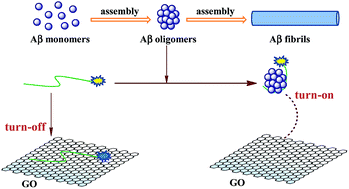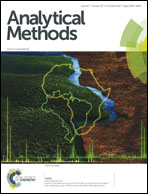A graphene oxide-based fluorescent platform for selective detection of amyloid-β oligomers
Abstract
Amyloid-β oligomers (AβOs) have been regarded as reliable molecular biomarkers for Alzheimer's disease (AD) diagnosis and crucial targets for therapeutic intervention. In this work, we report a graphene oxide (GO)-based fluorescence method for the selective detection of AβOs based on the strong and specific interaction between AβOs and the PrP(95–110) peptide, a segment of the cellular prion protein. Specifically, fluorescein isothiocyanate (FITC)-labeled PrP(95–110), denoted as FITC-PrP(95–110), was adsorbed onto the surface of GO via electrostatic and π–π interactions, which resulted in effective fluorescence quenching. However, in the presence of AβOs, the competitive binding of AβOs with GO for the peptide probe blocked the interaction between GO and FITC-PrP(95–110), which resulted in the recovery of the fluorescence signal. As a result, a detection limit of 1 nM for AβOs (equivalent monomers) was achieved. The amenability of this method to AβO analysis in a biological matrix was demonstrated by assaying AβOs in artificial cerebrospinal fluid. In contrast to other reported methods for AβO detection, our method is simple, rapid, cost-effective, highly selective, and obviates the need for a less stable antibody. We believe that our approach offers a new method for clinical diagnosis of AD and routine laboratory investigation for understanding the dynamics and mechanism of the Aβ aggregation/fibrillation processes.

- This article is part of the themed collection: Alzheimer's Research Month 2016

 Please wait while we load your content...
Please wait while we load your content...